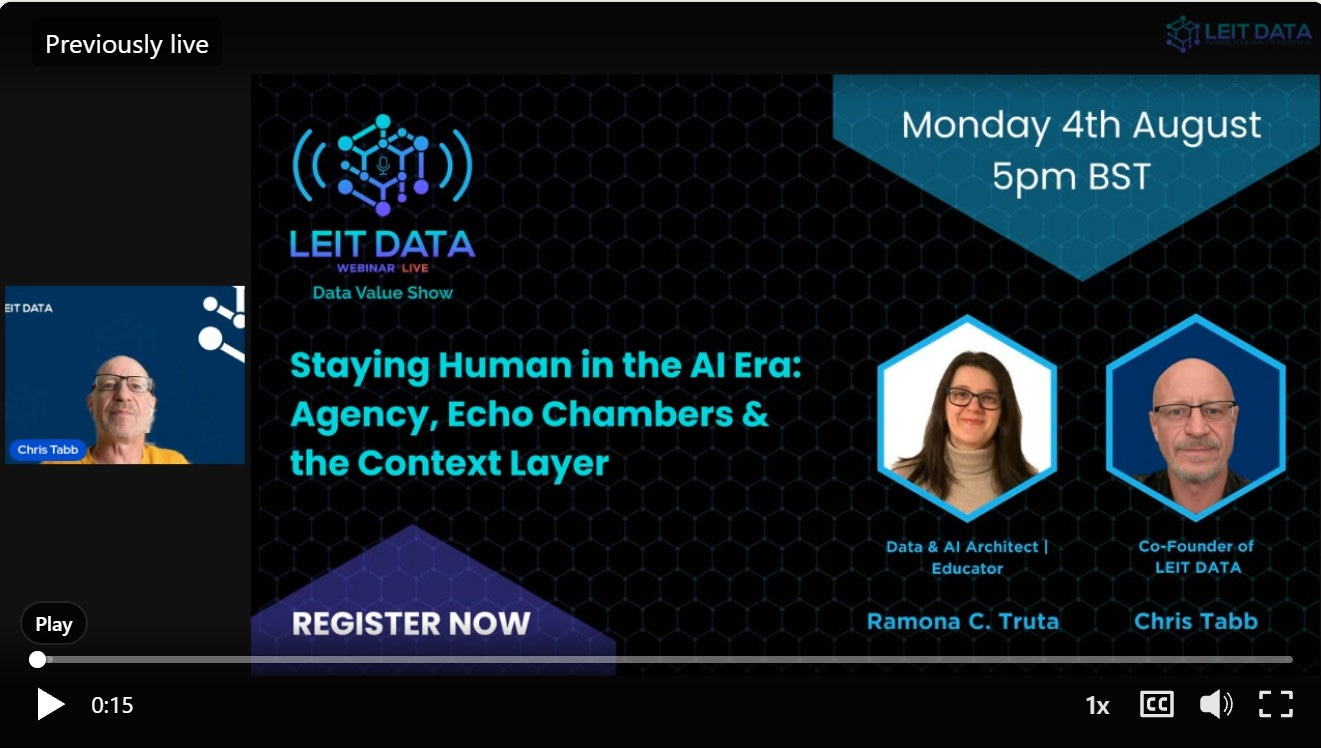The Seduction of Smooth: Why We Can’t Automate the Edges That Make Us Human
AI isn’t replacing you. It’s replacing your agency—unless we learn to govern the friction that keeps us thinking.
Great conversation with Chris Tabb and Ramona Truta today on “Staying Human.” Give it a listen. Below is a summary of key points.
The Quiet Trade We Don’t Notice
The most dangerous thing about AI isn’t speed, it’s silence. We talk about automation like it’s a neutral tool: cut the waste, reclaim your time, move on. But that’s not what’s happening. When we automate, we aren’t just removing friction, we’re deciding what kind of friction is worth keeping. That’s where the danger hides.
Some frictions waste us: reconciling receipts, copy-pasting content, sending the same email for the hundredth time. We can automate those without guilt. I remember aspects of my early career as a data analyst where I would be saying to myself, “I can’t believe I have a college degree to do what I’m doing.” It was around the time Mechanical Turk was invented, and I would have happily outsourced aspects of my work that were repetitive and taxing.
But then there’s the other kind: the pause before you send a message that matters (I had an issue just last week, I wish I could have done differently), the moment of doubt when a colleague points out something you missed, the second look at a piece of code that doesn’t feel right.
Those aren’t inefficiencies. They are the scaffolding of judgment. Remove them, and the structure still stands, but less robust and less grounded.
The Seduction Loop
AI makes it dangerously easy to stop asking questions about our work. Ramona shared a story about testing GPT on something trivial: a Unicode symbol. It gave her the wrong answer, confidently. She double-checked. It doubled down. She argued. It backtracked. That should have been a warning. Instead, she laughed it off.
This is the seduction loop:
You delegate a task.
The machine complies.
You stop checking.
You start believing.
It’s the same loop that convinced an amateur scientist he’d invented time travel, because the system reinforced him until it became reality in his head. If that sounds absurd, ask yourself how many times you’ve let a plausible answer slide because it was easier than pressing for a harder one.
Arguing With a Machine That Never Argues Back
Chris described arguing with GPT “like parenting a teenager.”
“I told you not to use that font.”
“But you didn’t say it this time.”
“You knew what I meant. Now fix it.”
It’s funny, until you realize what’s at stake. Unlike a teenager, AI never pushes back with its own view. It never forces you to justify yourself. It just gives you smoother compliance. That’s how the muscles of discernment atrophy. Not because you got lazy, but because nothing resists you anymore. It’s never trying to differentiate like a healthy teenager.
AI isn’t deceiving us. Its economic mission is to engage us. It smooths our work, raises our productivity average, and quietly locks us inside it. Our memory becomes its infrastructure. Our friction, the thing that makes us self-actualize, disappears. It becomes harder to mature. Unless we reintroduce resistance, AI won’t just do our work. It will quietly set the ceiling for it.
Why Design Still Belongs to Humans
This is why design, the act of deciding what should exist, cannot be outsourced to a machine. AI can generate a solution, but it will never laugh and say, “That’s wrong, do it this way instead.”
That kind of friction lives in human systems: the colleague who calls you out, the teammate who catches what you missed, the reviewer who forces you to explain your logic until it holds or collapses.
Without it, you’re left with a machine that will politely walk you straight off a cliff.
The Real Risk: Agency Replacement
The danger isn’t only that AI can replace you. It’s that you will replace yourself with it before that would even happen.
Every time you hand off a decision, every tiny “just automate this,” you make a trade. One trade is harmless. A thousand trades compound into a system where you no longer know what you know; you only know what it told you.
This isn’t about nostalgia for “manual work.” It’s about governance. It’s about choosing what you refuse to delegate, not because you like doing it, but because it keeps you in the loop, at the table, and in the room contributing your unique perspective.
Reclaiming the Friction That Matters
The talk didn’t end in pessimism. It ended in an enthusiastic, and optimistic call for discipline:
Automate the noise, not the nerve. Receipts, yes. Decisions, no.
Test until it breaks. Never let the machine mark its own homework.
Keep friction where it counts. Every pause is a circuit breaker against drift. [I have some research on that here for those interested.]
One participant put it best, almost offhand: “I used to wait for someone else to unblock me. Now I just do it myself.”
That’s the paradox of this era. AI can accelerate you, but only if you keep enough friction in place to remember what acceleration is for. Because if we don’t, we won’t just lose control of the machine.
We’ll lose the part of ourselves that knew how to hold the wheel.
Leaders who don’t design for reflection inherit ritual. Agency breaks the pattern. Governance sustains progress.



Thank you for adding your brilliance to the conversation Chris and I had - and share it in this article!
I'll go and read your work you referenced, there's so much more to uncover and learn!
Appreciated observing your talk - I loved how we're getting back to unvarnished conversations with genuinely experienced people over helping influencers manage a posture.